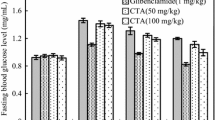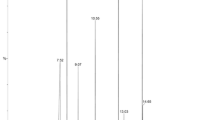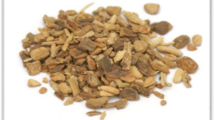Abstract
Effect of oral administration of 200 mg/Kg body weight of the aqueous extract ofOcimum sanctum (Tulsi) mixed with diet for eight weeks to diabetic (streptozotocin induced) rats was studied. There was significant reduction in fasting blood glucose, serum lipid profile, lipid peroxidation products, (LPO) and improvement in glucose tolerance. The aqueous extract also decreased LPO formation (thiobarbituric acid reactive substances TBARS) and increased antioxidant enzymes superoxide dismutase (SOD), catalase (CAT), glutathione peroxidase (GPX), glutathione transferase (GT) and one antioxidant reduced glutathione (GSH) in plasma and rat liver, lung, kidney and brain. The decrease in TBARS and increase in GSH, SOD, CAT, GPX, and GT clearly shows the antioxidant property ofOcimum sanctum.
Similar content being viewed by others
References
Satyavati, G.V., Raina, M.K. and Sharma, M. (1976) Medicinal plants of India, Indian Concial of Medical Research, New Delhi. p.65–68.
Dhar, M.L., Dhar, M.M., Dhawan, B.N., Mehrotra, B.N. and Ray, C. (1968) Screening of Indian plants for biological activity. Part1. Ind. J. Exp. Biol. 6, 232–238.
Shukia, R., Sharma, S.B., Puri, D., Prabhu, K.M. and Murthy, P.S. (2000) Medicinal plants for treatment of diabetes mellitus. Ind. J. Clin. Biochem. 15 (August, suppl.), 169–177.
Pushpangadan, P. and Sobti, S.N. (1977) Medicinal properties of Ocimum (Tulsi) species and some recent investigations of their efficacy. Indian Drugs 14, 207–208.
Gupta, S. (1967) Pharmacognosy of leaves of different species of Ocimum (Tulsi). Ind. J. Med. Res. 2 (1), 35–38.
Chattopadhyay, R.R. (1993) Hypoglycaemic effect ofOcimum sanctum leaf extract, in normal and streptozotocin diabetic rats. Ind. J. Expt Biol. 31, 891–893.
Bhargava, K.P. and Singh N. (1991) Anti-stress activity ofOcimum sanctum Linn. Ind. J. Med. Res. 73, 443–451.
Rai, V. and Iyer. U.V. (1997) Effect of Tulsi (Ocimum sanctum) leaf powder supplementation on blood sugar levels, serum lipids and tissue lipids in diabetic rats. Plant Foods Hum. Nutr. 50 (1), 9–16.
Agrawal, P., Rai, V. and Singh, R.B. (1996). Randomized placebo-controlled, single blind trial of holy basil leaves in patients with non-insulin dependent diabetes mellitus. Int. J. Clin. Pharmacol. 34 (9), 406–409.
Hussain, H.E.M.A., Jamil, K. and Rao, M. (2001) Preliminiary studies on the hypoglycaemic effect ofAbroma augusta in alloxan diabetic rats. Ind. J. Clin. Biochem. 16 (1), 77–80.
Poliodoro, G.D.T., Arduini, R.G.L.A. and Federici, G. (1984). Superoxide dismutase, reduced glutathione and Tba-reactive products in erythrocytes of patients with multiple sclerosis. Int. J. Biochem,. 16 (5), p.505–509.
Hiroshi, O., Nobuko, O. and Kunio, V. (1979) Assay for lipid peroxides in animal tissues by thiobarbituric acid reaction. Anal. Biochem. 5, 351–358.
Wendel, A. (1981) Glutathione peroxidase. In: Methods in Enzymology, Ed. Jakoby, W.B. Acadamic Press, New York, U.S.A. vol. 77, p.327–333.
Mohan, V., Ramachandran, A. and Viswanathan, M. (1985) Tropical diabetes. In: The diabetes Annual I, Eds. Aiberti, K.G.M.M., Krall, L.P. Elsevier Science, Amsterdam. p.82–92.
Baynes, J.W. (1991) Role of oxidative stress in developments of complications of diabetes. Diabetes. 40, 405–412.
Vernon, R. (1981) Psychoneuroendocrine influences on immunocompetence and neoplasia Science, 212, (20), 1100–1110.
Yagi, K. (1987) Lipid peroxides and human disease. Chem. Phys. Lipids. 45, 357–402.
Author information
Authors and Affiliations
Rights and permissions
About this article
Cite this article
Hussain, E.H.M.A., Jamil, K. & Rao, M. Hypoglycaemic, hypolipidemic and antioxidant properties of tulsi (Ocimum sanctum linn) on streptozotocin induced diabetes in rats. Indian J Clin Biochem 16, 190–194 (2001). https://doi.org/10.1007/BF02864859
Issue Date:
DOI: https://doi.org/10.1007/BF02864859




